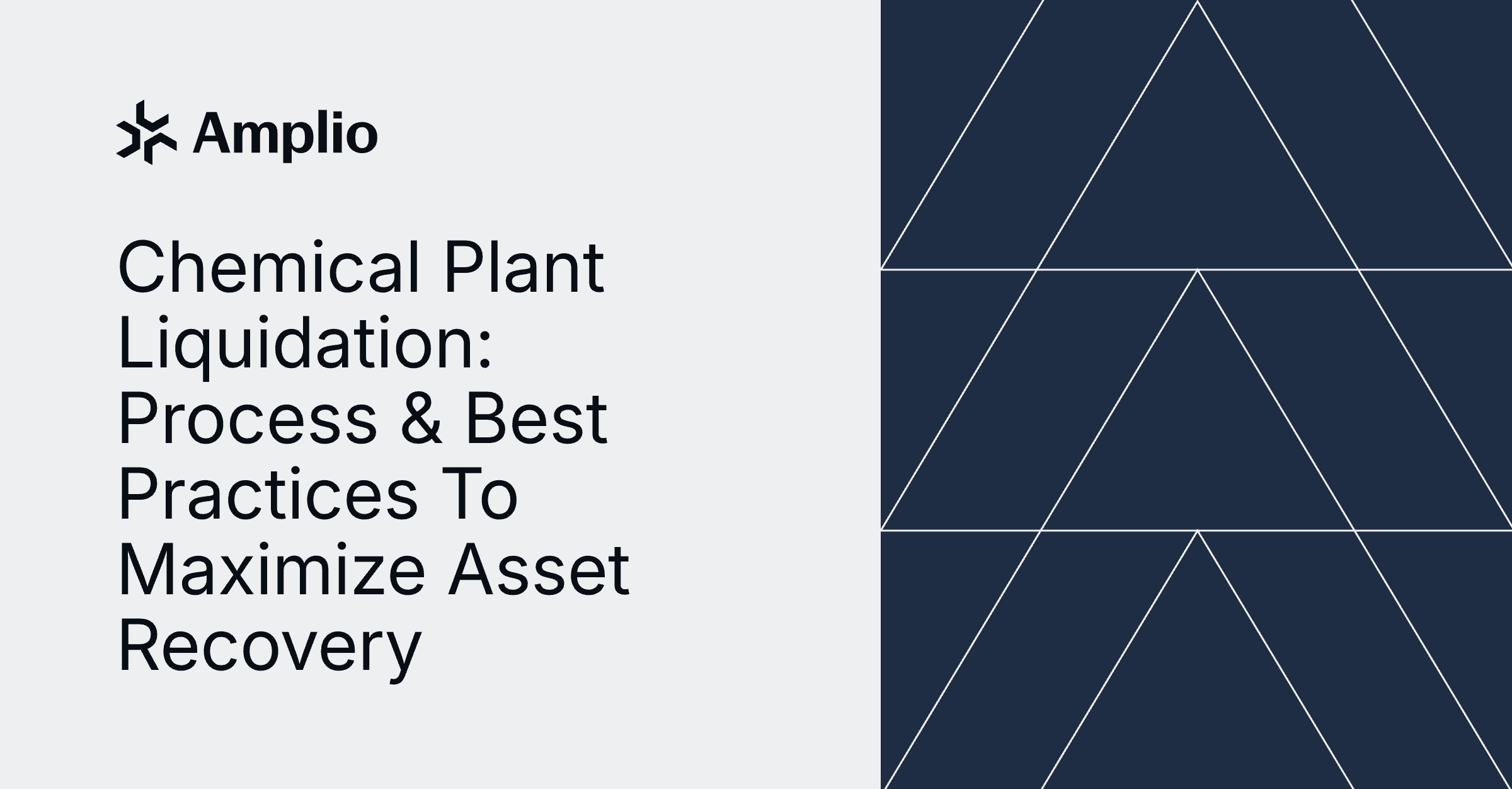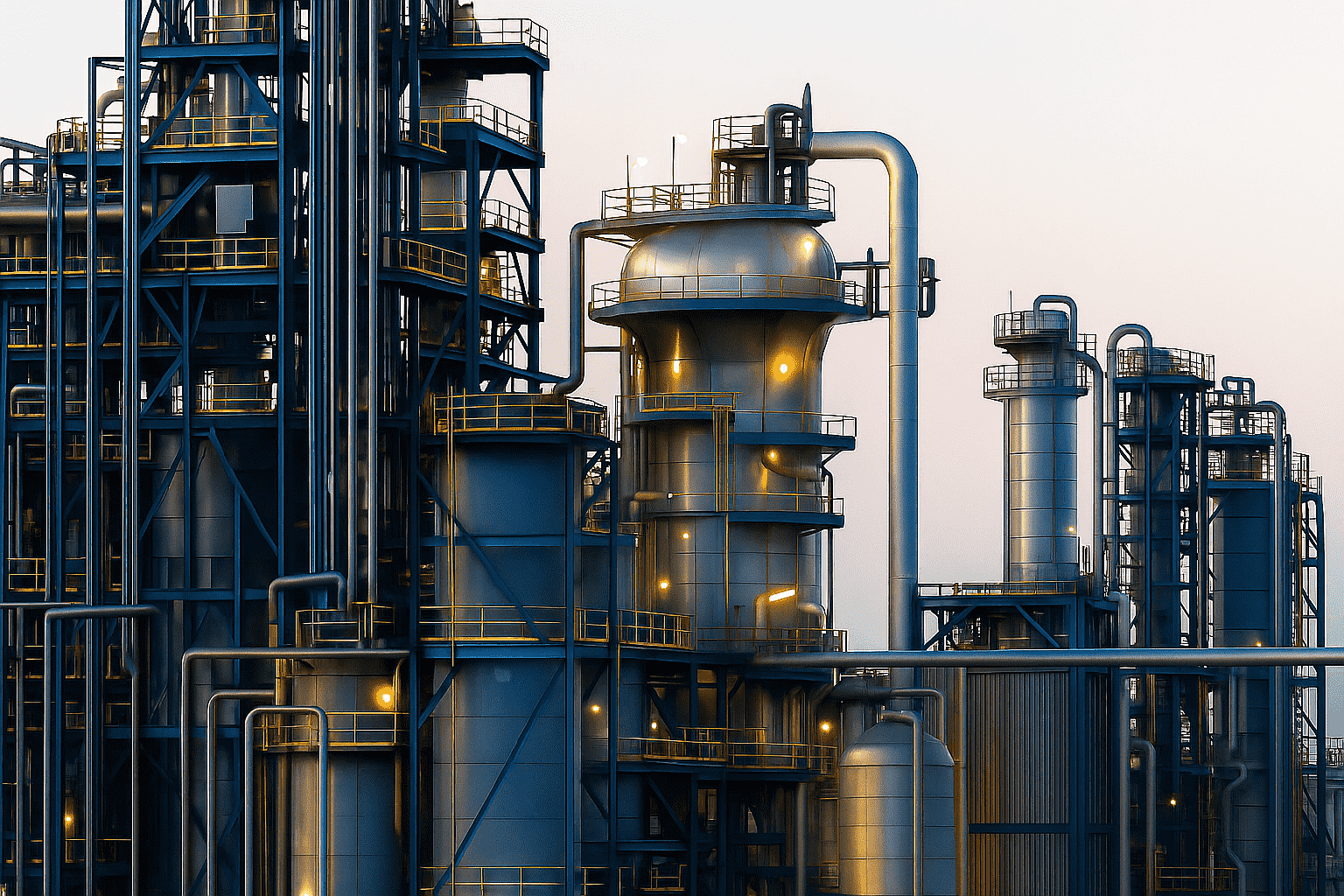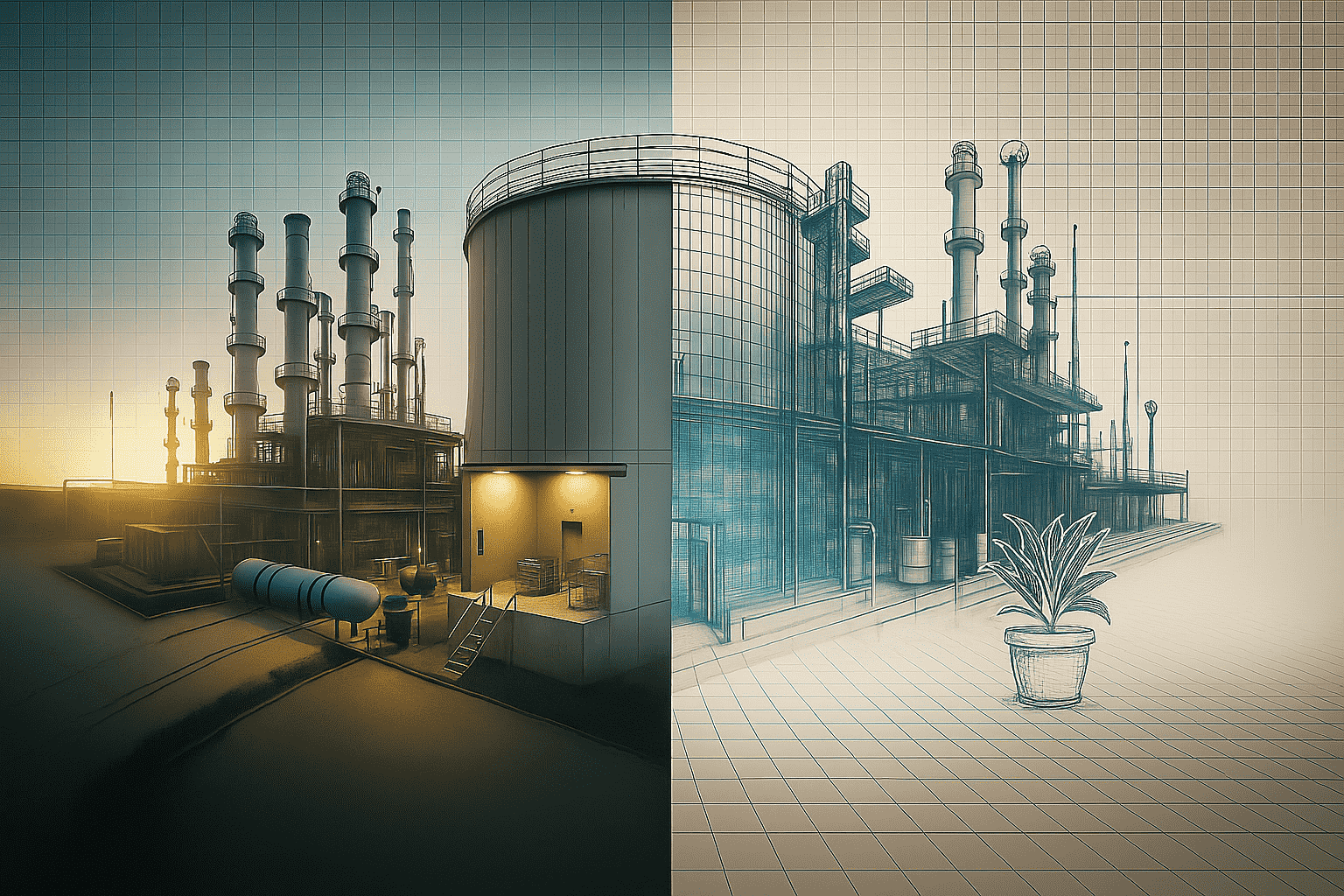Chemical Plant Liquidation: Process & Best Practices To Maximize Asset Recovery

Introduction

Chemical plant liquidation is the process of systematically selling off plant assets—machinery, processing lines, infrastructure, and surplus inventory—when operations cease or facilities are repurposed.
For plant owners and stakeholders, maximizing asset recovery is not just about recouping investment; it’s a strategic move to protect working capital, reduce environmental liability, and free up resources for future initiatives.
The chemical sector presents unique liquidation challenges. Safety risks are elevated, given the complexity of integrated process equipment and site infrastructure. Asset values can be volatile, especially when dealing with specialty systems or legacy technology.
In this blog, you’ll find a straightforward process and proven best practices to help you maximize asset value, minimize risk, and ensure a smooth, compliant transition when liquidating a chemical plant.
The Chemical Plant Liquidation Process

A successful chemical plant liquidation, like for any other plant liquidation, requires a disciplined, step-by-step approach that protects value at every stage. Here’s how to execute the process for maximum asset recovery and minimal risk:
Pre-Liquidation Preparation
1. Asset Inventory and Documentation
Start your liquidation process with a rigorous, comprehensive inventory of all plant assets. This includes every piece of machinery, process equipment, MRO supplies, spare parts, and supporting infrastructure.
Leverage digital asset management systems to centralize records and enable real-time tracking. Use asset tagging and up-to-date condition reports to give prospective buyers full transparency into what’s available. The more precise your documentation, the easier it becomes to market assets, justify valuations, and facilitate a smooth sale.
A disciplined approach at this stage ensures you capture maximum value, streamline negotiations, and avoid delays that can erode recovery.
2. Regulatory, Safety, and Environmental Assessment
Effective chemical plant liquidation hinges on strict regulatory compliance and proactive risk management.
Begin by identifying all hazardous materials on site—including residual chemicals, process by-products, and contaminated equipment. Plan and execute thorough decontamination protocols to ensure every asset meets environmental and safety standards before removal or sale.
Full compliance with the Environmental Protection Agency (EPA), Occupational Safety and Health Administration (OSHA), and all local environmental regulations is non-negotiable. This includes proper documentation, clear labeling, and adherence to required handling and disposal procedures. Early coordination with regulatory agencies streamlines permitting, minimizes project delays, and prevents costly violations.
Timely notifications to authorities and stakeholders are essential. Addressing regulatory and environmental requirements from the outset protects your organization, supports smooth asset transfers, and demonstrates your commitment to safety and environmental stewardship.
Chemical Plant Liquidation
1. Valuation and Appraisal of Plant Assets
Engage qualified appraisers with experience in the chemical industry to assess the value of your plant assets. An accurate valuation is essential for setting expectations, negotiating with buyers, and maximizing recovery.
Use multiple valuation methods to capture the full picture:
- Comparative market approach evaluates asset value based on recent sales of similar equipment.
- Income approach estimates value according to the asset’s potential to generate income over time.
- Liquidation value approach determines the expected return if assets are sold quickly under forced-sale conditions.
Note: Pay special attention to specialty equipment and integrated process lines. These often require technical documentation and expert insight to properly value, especially if they serve niche applications or involve custom configurations. Proper appraisal ensures you target the right buyers and defend your price in the market.
2. Disposition Strategy
Your planning and selection of a disposition strategy will determine both the speed of your asset liquidation and the value you recover. Prioritize these key factors to ensure optimal results:
i) Explore the Range of Sales Channels
Consider the full range of sales channels. Select the channel that aligns with your goals, timeline, and asset profile:
- Auction: Fast, competitive bidding—ideal for assets in strong demand or when time is limited.
- Industrial Liquidators: They often buy and facilitate the selling of equipment, effective for clearing large volumes or low-demand items.
- Negotiated Sale: Direct negotiation with buyers—suitable for high-value or specialized equipment.
- B2B Consignment: Partner with a third party to market and sell assets on your behalf; you retain ownership until sale.
- Online Marketplaces: Global reach with targeted listings—connects with buyers across industries and geographies.
ii) Target Buyer Segments
Target industrial buyers who can extract the most value from your assets. This includes direct end-users looking to upgrade capacity, brokers with established resale networks, dealers specializing in specific equipment categories, and international buyers seeking cost-effective solutions.
iii) Asset Packaging Approaches
Strategically package assets to match buyer demand. You may offer bulk lots for large-scale buyers, complete systems for turnkey solutions, or break down high-value equipment for individual sales. Tailoring your approach to market needs drives better pricing and increases the likelihood of a successful, timely liquidation.
3. Decommissioning & Dismantling
Once the disposition channels are identified, moving on to safe and efficient decommissioning is critical to both asset value and regulatory compliance.
Begin by isolating and shutting down all systems according to industry best practices. This step protects both personnel and remaining assets during removal.
Plan the sequence of asset removal to ensure safe access and prevent damage—prioritize high-value equipment and address any hazardous systems early in the process.
Engage qualified contractors with expertise in dismantling, rigging, and handling hazardous materials. Their experience minimizes risk, reduces liability, and maximizes the value recovered from each asset.
Thorough planning and expert execution at this stage prevent costly incidents and support a smooth, timely transition to sale or transport.
4. Logistics & Compliance
Clear, proactive logistics planning ensures every asset transfer is efficient and compliant. Early in negotiations, define responsibilities with the buyer—determine who will manage routing, permits, and physical handling of each asset.
Map out each movement, securing required permits and coordinating transport for standard and oversized loads. Attention to compliance is essential at every stage, minimizing the risk of delays or penalties.
Equip buyers with comprehensive documentation, including technical specifications, maintenance histories, and decontamination certificates. Well-prepared paperwork streamlines the transfer process, accelerates payment, and builds buyer confidence in the transaction.
5. Final Site Clearance & Documentation
Once assets are removed, complete site remediation to meet all regulatory standards. Proper cleanup protects your organization from future environmental claims and demonstrates your commitment to responsible operations.
Maintain detailed records for every stage of the process—asset sales, decontamination, and site closure. Comprehensive documentation not only ensures audit, tax, and compliance requirements are met but also provides a clear record for internal and external stakeholders. This final step secures your organization’s reputation and minimizes post-liquidation risk.
Best Practices to Maximize Asset Recovery From Your Chemical Plant Liquidation

1. Early Asset Valuation and Market Analysis
Getting a head start on asset valuation and market research is critical. Assess your plant assets as soon as liquidation becomes likely—timing has a direct impact on recovery. Entering the market before major shutdowns are announced allows you to capture demand from buyers still seeking replacement or expansion equipment.
Conduct a thorough market analysis to identify which assets are in highest demand or serve niche applications. Specialty equipment, recent model process lines, and well-maintained support systems often command premium pricing when positioned correctly.
Early identification of these high-value items enables targeted marketing and stronger negotiation leverage, ensuring you don’t leave money on the table.
2. Lotting and Packaging Strategies
Strategic lotting and packaging have a direct impact on both sale speed and recovery value. Consider bundling high-value assets or complementary systems to attract premium buyers who seek turnkey solutions or operational scale. For less specialized equipment, breaking down lots into individual items can broaden your reach and appeal to a wider pool of buyers.
Support every lot with complete technical documentation, up-to-date maintenance logs, and all relevant certifications. Well-prepared packages not only increase buyer confidence but also streamline due diligence and accelerate the closing process. These details can be the difference between a quick, high-value transaction and assets left unsold.
3. Leveraging Secondary Markets and Industrial Networks
Tapping into secondary markets and established industrial networks expands your buyer pool and drives up competition for your assets.
Work with trusted liquidation specialists and online platforms that know the chemical and process equipment sectors. These partners connect you directly with qualified buyers and help you navigate market dynamics.
They also open doors to industrial circularity and landfill diversion, connecting you with buyers in related industries. Equipment that’s obsolete for you may be essential for another operation. This approach cuts waste, accelerates sales, and advances your sustainability goals.
4. Documentation and Compliance
Maintain accurate, up-to-date records for every transaction throughout the liquidation process. Comprehensive documentation—covering asset sales, transfers, and site remediation—not only satisfies audit, tax, and legal requirements but also protects your organization from future disputes.
Ensure every buyer receives full information on environmental, health, and safety compliance related to their purchased equipment. Providing clear guidance helps them meet their own regulatory obligations and safeguards your reputation.
Facilitate the transfer of all relevant warranties, technical manuals, and engineering drawings. This transparency adds value for buyers, reduces follow-up inquiries, and ensures a smooth transition of ownership. Proper documentation and compliance practices are essential for closing the liquidation with confidence and integrity.
How Amplio Supports Chemical Plant Liquidation

Amplio provides a comprehensive platform to help you unlock more value from your chemical plant liquidation:
- Centralized Asset Registry and Valuation Tools
Maintain an organized, digital inventory and receive expert asset appraisals to set the right price from the start. - Trusted Network of Global Buyers and Industrial Partners
Access a vetted buyer and seller network—connecting your assets with serious industrial buyers and sellers in the United States. - End-to-End Compliance Management and Logistics Support
Simplify regulatory approvals and ensure every move, from decontamination to export, is managed professionally and safely. - Real-Time Dashboards and Transparent Sales Reporting
Monitor sales progress and recovery metrics at every stage, with complete transparency and control over your results. - Expert Guidance on Maximizing Recovery and Minimizing Risk
Leverage Amplio’s industry knowledge to navigate complex sales, avoid costly mistakes, and achieve a smooth, successful liquidation.
Partner with Amplio to streamline your process, mitigate risks, and secure maximum recovery from your chemical plant assets.